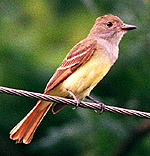

|
While some of these birds may be familiar, others are only at home in the deep forest away from the places frequented by people. The white-breasted nuthatch is at home in the backyard, the city park or the woods, while the scarlet tanager is found only where large unbroken tracts of forest remain. |
Since habitat left undisturbed by people is rare, it is no wonder that birds living in the forest interior are suffering. (For more about the loss of forest habitat, please see our page on warblers) When watching birds, take note of where you find them. You may learn which species are flourishing because they have adjusted to civilization, and which ones are not. |
 |
 |
 |
| The hermit thrush often flicks its rusty red tail high and gradually lowers it to normal position. | Despite its bright red color, the scarlet tanager may be hard to find because it lives deep in the forest. | Watch the white-breasted nuthatch as it comes headfirst down a tree. It's short, loud call will soon become recognizable. |
 |
 |
 |
| The markings on the wood thrush's chest are very apparent. They are residents of wooded areas, preferring bottomland forest. Wood thrushes can be found nesting in Illinois. | The veery has fewer spots than its thrush relatives. The spots are seen around the neck and throat area. Veeries sometimes nest here, mostly in the northern part of Illinois. | The tufted titmouse is a common resident of woodland areas. They also come to feeders in backyards and are seen in parks. |
 |
 |
 |
| The brown creeper is endangered in Illinois. They are most at home in floodplain woods and the cypress swamps of southern Illinois. The nest is built in the gap left when loose bark separates from the tree. | The brown thrasher is one of the early spring arrivals and is easily seen along roadways where it forages in hedgerows. They normally return from migration in March. | The Carolina wren is a bird of southern bottomwood forests that has extended its range northward. They can also be seen in residential areas around brush piles and vines. They are found year round in the southern part of the state. |
 |
 |
 |
| Gray catbirds are found at the forest's edge, rarely in the interior. They can be found nesting in backyards where habitat is suitable. They have a variety of calls and may include several "catlike" sounds. | Sure, ruby-crowned kinglets have a red crown, but is almost always hidden unless the bird is agitated. | Note the dark black line that is visible over the eye in the blue-gray gnatcatcher. They use spider webs to keep their nest together in a nice neat cup. |
 |
 |
 |
| In its summer plumage, the male summer tanager is the only all red bird in Illinois. The females are not red, but greenish-yellow. They prefer the oak trees of upland woods. | The northern (or Baltimore) oriole is sometimes hard to spot because it operates high in the forest canopy. | The pine grosbeak sometimes makes a winter visit to northern Illinois. They are robin-sized finches and have been know to come to feeders. Note the white wing bars. |
 |
 |
 |
| The red crossbill has a crossed bill, perfect for prying pine cones apart. Click here for a closeup picture of the bill. | Great crested flycatchers are fairly large, but are hard to find because they are often hidden by foliage. They prefer forest interiors. For more about flycatchers, click here. | The whip-poor-will is the same color as the woodlands where it makes its nest. It is a member of the nightjar family. Click here for a larger version of the picture. |